Rivers bring life to communities, and the Mississippi River is an essential part of life for much of the United States. It plays an integral role in industrialization and hydroelectricity and provides recreational opportunities for 10 states.
Have you ever wondered what lives at the bottom of the Mississippi River? Fish, reptiles, amphibians, mammals, and plants live in this mighty body of water. Plus, discover the most exciting creatures that lurk beneath its surface.
A Snapshot of the Mississippi River

The Mississippi River is the second-longest river in North America, and its source comes from Lake Itasca in Minnesota. It flows south for over 2,000 miles until it reaches the Gulf of Mexico and borders or passes through ten states on its long journey.
Fifty thousand years ago, the central United States was covered by an inland sea. The Mississippi River and its many streams drained this sea into the Gulf of Mexico and left behind extensive flood plains. These areas like Louisiana now contain incredibly fertile soil.
Native Americans lived around the Mississippi River for thousands of years, and some had even started more advanced and modern civilizations. During the 16th century, European explorers and settlers drove them from their homes and used the river for transportation and communication. In the 19th and 20th centuries, there was a substantial increase in engineering work, and steamboats transported goods for agriculture and industry.
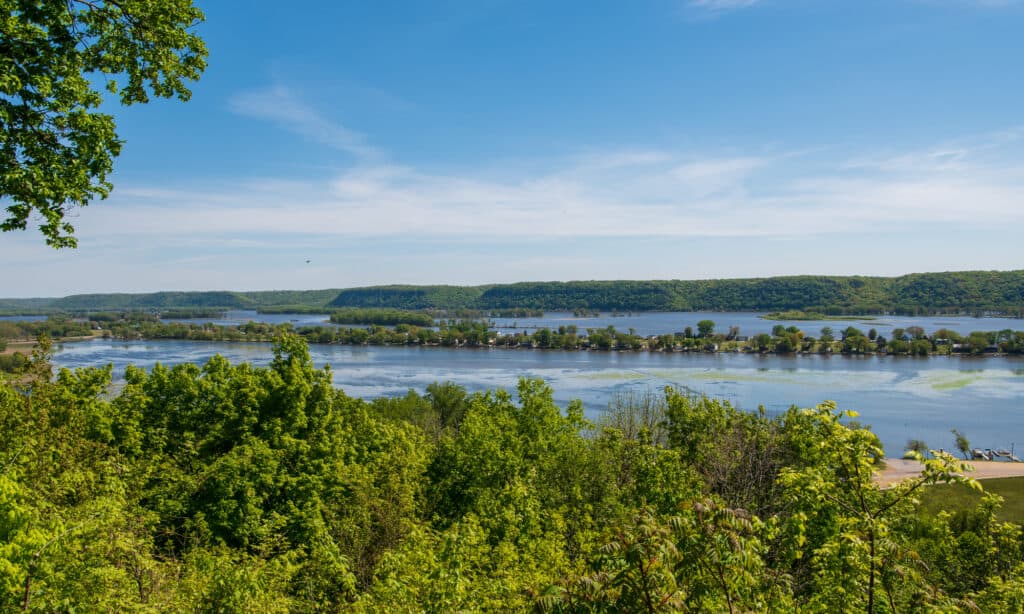
The Mississippi River is over 2,000 miles long and passes near or through 10 states.
©Ralf Broskvar/Shutterstock.com
In modern times, we’ve seen significant pollution from agricultural runoff, which is the main contributor to the Gulf of Mexico dead zone. What makes this river dangerous besides pollutants, and should you swim in it?
Is the Mississippi River Dangerous?

The Mississippi River has powerful currents and is heavily polluted.
©Akarat Phasura/Shutterstock.com
The Mississippi River can be dangerous to swim in. This river has powerful currents that can sweep away vehicles. When people are in the water, the current pushes them with an intense velocity. That water moving on you can easily send you underwater, fighting for breath. You should wear a life jacket and don’t leave children unattended.
When swimming in this river, park rangers advise you to keep your mouth shut and avoid swallowing any water. Sewage, industrial waste, farm, and urban overflow pollute the river throughout the year. These pollutants have contaminated many fish populations and contain mercury and other chemicals. If you ingest the river water or consumer too much of its fish, you may experience flu-like symptoms.
What Lives at the Bottom of the Mississippi River?
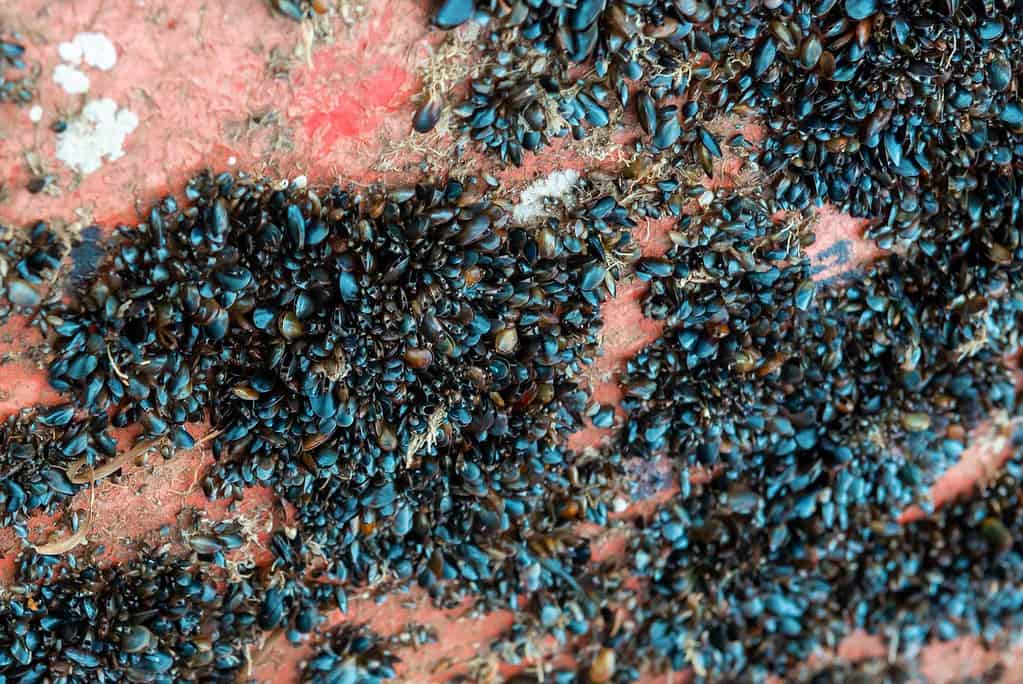
Mussels, perch, crayfish, and phytoplankton live at the bottom of the Mississippi River.
©Dolores M. Harvey/Shutterstock.com
Perch, mussels, crayfish, phytoplankton, and many other fish and crustaceans live at the bottom of the Mississippi River. The water depth varies depending on where the river flows, but the average depth is 3 to 12 feet (3.66 m). There are over 120 fish species in the Mississippi River, and you can find them all around. Some of the most unusual creatures you might find in the great Mississippi are alligators, sharks, blue catfish, American eels, Gulf sturgeon, and paddlefish.
Alligators
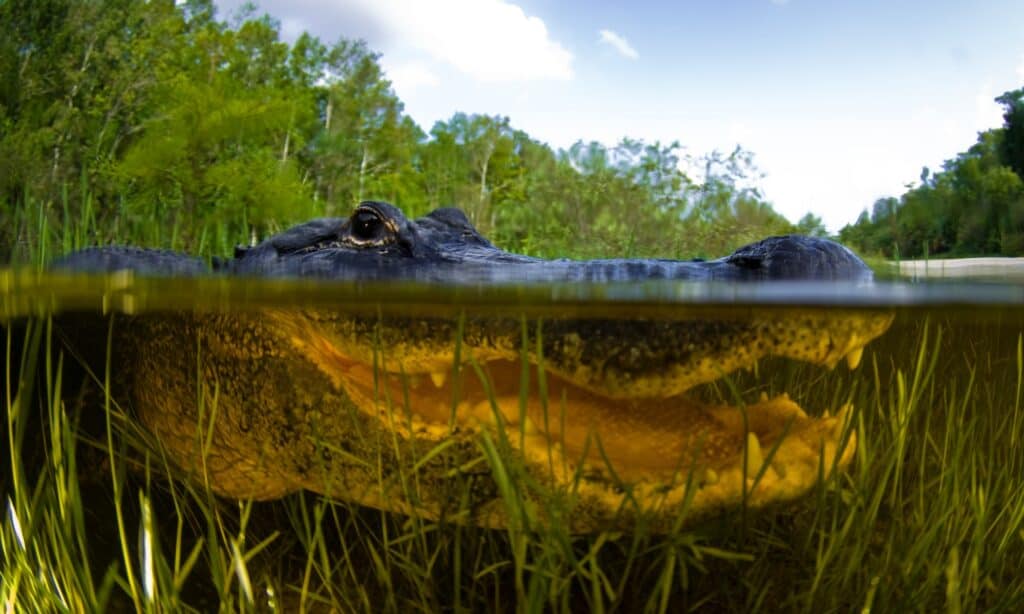
Alligators inhabit marshes around the Mississippi River.
©tswinner/Shutterstock.com
American alligators live in swampy marsh areas around the Mississippi River. However, it’s unknown how far north their reach is. These crocodilian reptiles are native to the southeastern United States and prefer tropical or subtropical freshwater wetlands like marshes and swamps. These apex predators can weigh over 1200 pounds (0.54 t) and grow over 16 feet (ca. 5 m). Most gators don’t attack humans unless they feel threatened. Don’t go into the river if you see an alligator; don’t try to feed it.
Bull Sharks
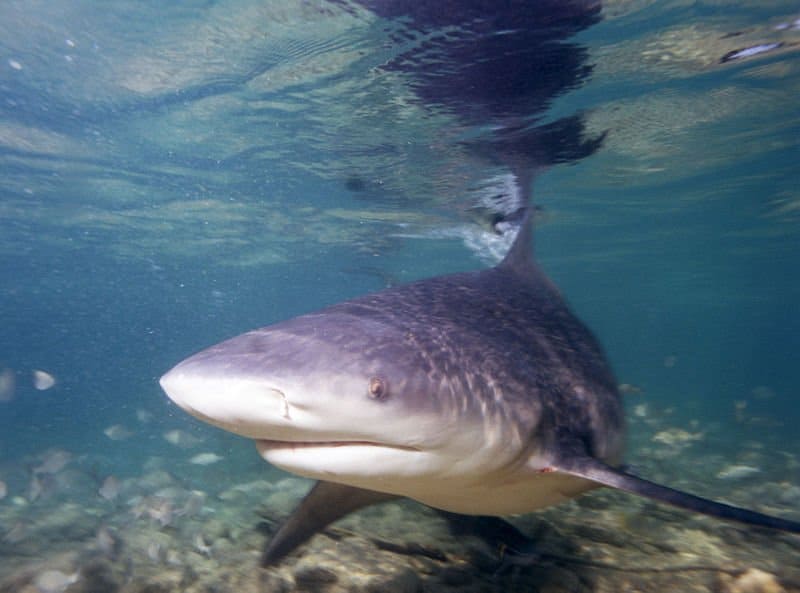
The bull shark is typically found in shallow, warm oceans, but it can travel up freshwater rivers.
©Albert Kok, CC BY-SA 3.0, via Wikimedia Commons – License
According to many experts, bull sharks are the most dangerous sharks in the world. They often inhabit water where many people recreate, and they can be very aggressive. Most people see bull sharks in warm, shallow ocean water, but they are known for finding their way up freshwater streams and rivers. This species eats almost anything, including other sharks, and will even attack a human. However, it is rare. Officials captured only two bull sharks from the Mississippi River during the entire 20th century.
Blue Catfish
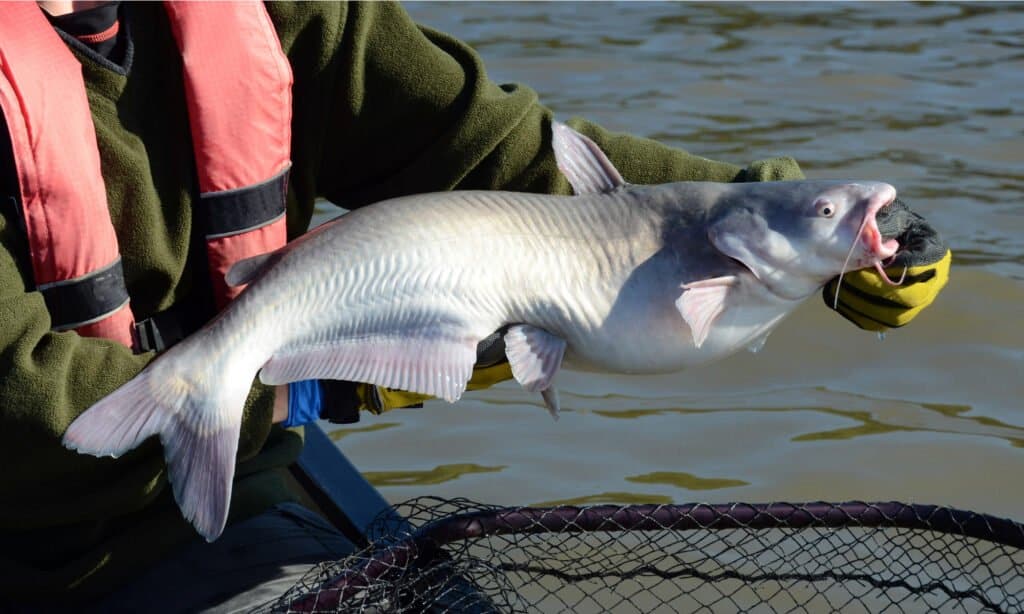
The largest blue catfish caught in the Mississippi weighed 131 pounds.
©M Huston/Shutterstock.com
Weighing up to 150 pounds (ca. 68 kg), the blue catfish is the largest of its species in North America. This behemoth-sized fish is native to the Mississippi River and is one of the few species in this water able to eat Asian carp (an invasive species). Considered a pest, this catfish lives up to 20 years, eats almost anything, and can survive in varying environments. The biggest blue catfish ever caught from the Mississippi was 131 pounds (ca. 59 kg).
Gulf Sturgeon

Gulf sturgeon are a threatened species and hard to find in the Mississippi River.
©Chase D’animulls/Shutterstock.com
Sturgeons, or “living dinosaurs,” evolved over 200 million years ago. These ancient fish can live up to 50 years old, weigh 300 pounds (0.14 t), and grow to over 6 feet (1.83 m) long. As impressive as these creatures sound, they are on the endangered species list, and it’s relatively rare to spot one in the Mississippi nowadays.
Overfishing is the primary reason for the sturgeon population’s decline. Freshwater fish have historically been sought as a food source, particularly its eggs for caviar. Industrial gelatin can be made from its swim bladder. Efforts are being made to educate sturgeon fishing communities about the importance of conservation and to restore key habitats for the species.
Paddlefish
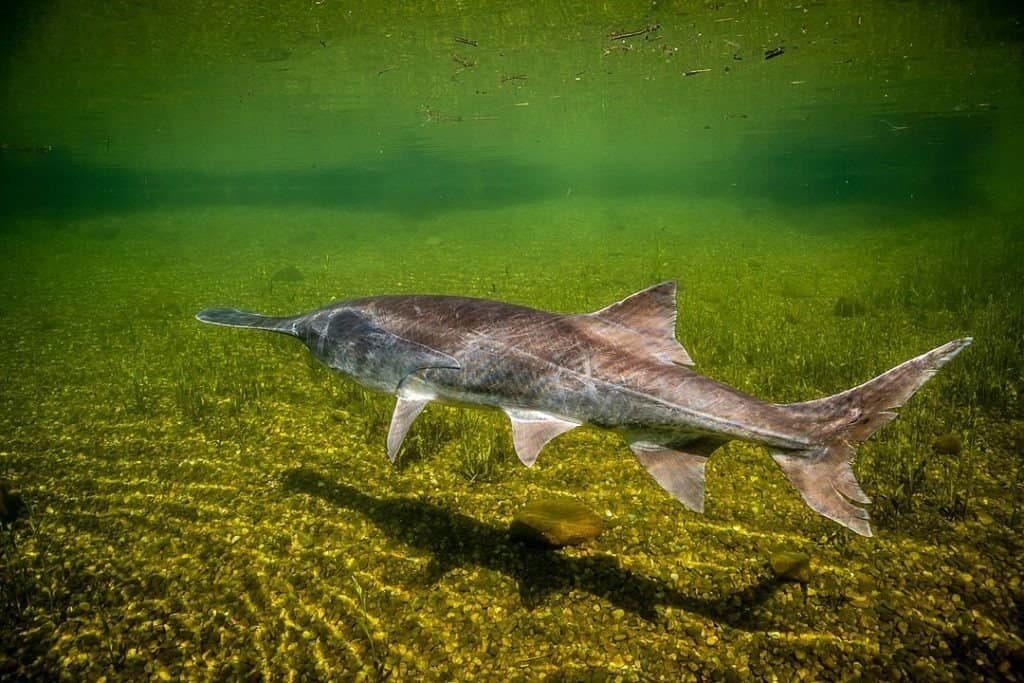
Paddlefish ancestors are 200 million years old.
©USFWS, Public domain, via Wikimedia Commons – License
The paddlefish is an unusual-looking creature with no teeth and a large mouth and can grow up to 7 feet (2.13 m). It has no natural predators, but it only eats plankton. Its ancestors lived over 200 million years ago, and its closest relative in modern times lived in the Yangtze River but is now extinct.
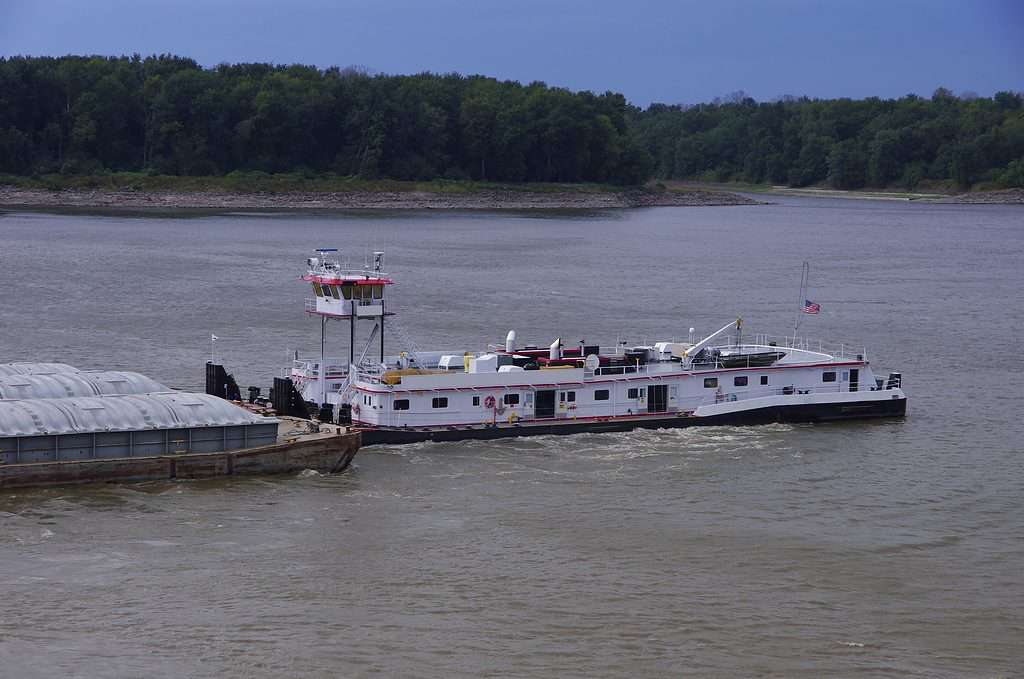
Around 92% of U.S. agricultural exports move through the Mississippi River Basin.
©RozenskiP/Shutterstock.com
Climate Change Making the River Unnavigable for Barges
River Barges are an important means of transporting heavy products and grains from one port to another in the United States and all over the world. The effects of climate change and the droughts it produces have caused water levels to fall so low that barges are unable to float. The Mississippi River fell so low in October 2022, that dredging and emergency water releases from upstream reservoirs were required to keep the river navigable. Over 2,000 barges were backed up at various points before extreme actions were taken. This extra expense, if it continues to be an issue, could raise the cost of goods all over the world. Scientists believe that the recent low levels in rivers are a preview of what is to come as climate change gets worse.
Shark vs. Alligator: Who Would Win in a Fight?
The size and strength of a shark make it clear who would win this fight. Sharks can grow to be up to 20 feet long and weigh as much as 1,400 pounds! Alligators max out at 13-15 feet in length and usually only reach around 500 pounds. This gives sharks an obvious edge when it comes to strength and power.
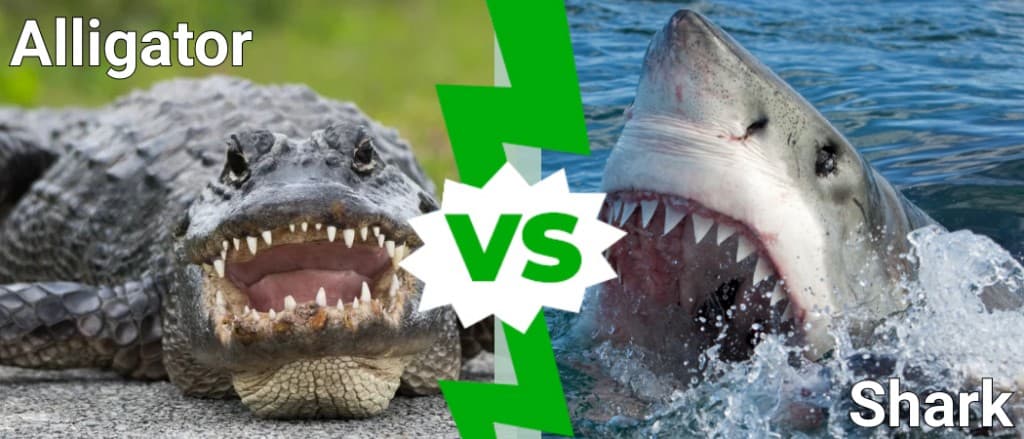
Sharks also have a powerful sense of smell that allows them to detect the alligator from far away in the water. Once they get close enough, they will rush towards the alligator with incredible force, driving their weight into its body while clamping down on vital areas like its head or limbs with their razor-sharp teeth.
The initial bite from the shark is almost guaranteed to land, causing immense damage that leaves the alligator unable to fight back effectively due to its poor vision combined with saltwater making it difficult for them to see where they are biting. In short, there’s no doubt about it: when these two creatures go head-to-head in a fight, the shark wins every time!
Interesting Facts about the Mississippi River
- The Mississippi River was once five miles wide, and whales swam up it from the Gulf of Mexico. Archeologists found whale bones in Michigan.
- The river was forced through New Orleans artificially through a series of floodgates.
- The Mississippi River temporarily ran backward after a series of earthquakes shook the valley in the early 1800s.
- On April 27, 1865, the Sultana steamboat exploded and sank to the bottom of the Mississippi River, killing over 1500 people.
- Over 7,000 rivers feed into the Mississippi.
- The widest point is where the river forms Lake Winnibigoshish, over 11 miles (ca. 18 km).
- Ralph Samuelson invented water skiing on the Mississippi River in the early 1900s.
- A Slovenian swimmer swam the entire length of the river in 68 days.
- A single drop of water takes 90 days to travel all the way down.
What Animals in the Mississippi River are Endangered?
Due to the changes that have occurred in the Mississippi River as the result of manmade redesign in the form of dams, locks, and channels, the ecosystem of the river has been affected significantly. Many of the species we’ve mentioned that inhabit the depths of the Mississippi have become endangered or threatened either within certain states the river runs through, or on a Federal level.
Multiple fish species have declined in numbers over the past 100 years due to 9-foot navigational channels being built which required the removal of gravel bars and shallows, creating a series of reservoirs and navigation pools. These changes to the river have caused the following fish species to be listed as endangered within the river: lake sturgeon, paddlefish, blue sucker, bluntnose darter, starhead topminnow, longear sunfish, crystal darter, goldeye, pallid shiner, and skipjack herring.
Changes that came about in water depth, temperature, and velocity of the river currents have affected populations of freshwater mussels as well. Several species of freshwater mussels, including Higgins eye, Rock Pocketbook, Spectacle Case, Purple wartyback, Butterfly, and others, are now listed as threatened or endangered at both state and federal levels.
The photo featured at the top of this post is © Milen Mkv/Shutterstock.com
Thank you for reading! Have some feedback for us? Contact the AZ Animals editorial team.






